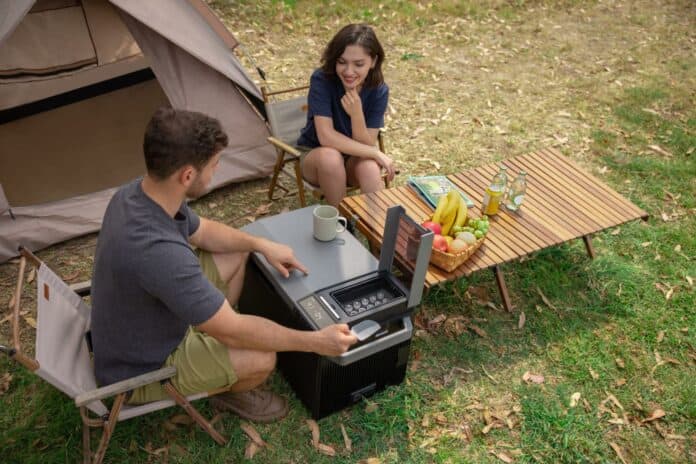There’s nothing like spending time outdoors and enjoying a peaceful camping trip out in nature.
But who says that just because you’re on a camping trip means you can’t enjoy all the same delicious food and beverages you do at home?
With the right portable refrigerator, you can enjoy fresh meat and vegetables, dairy and egg products, and frosty cold beverages — even on extended off-grid trips.
Speaking of cold drinks — would you like ice with that?
No problem.
Most camping fridges and coolers severely limit your options when it comes to what kind of grocery items you can take off-grid.
But how many cans of baked beans can you eat without souring on the whole camping experience?
With the right portable refrigerator, you can go from camping to glamping overnight.
Read on and find out how to select the best camping fridge for your next off-grid adventure.
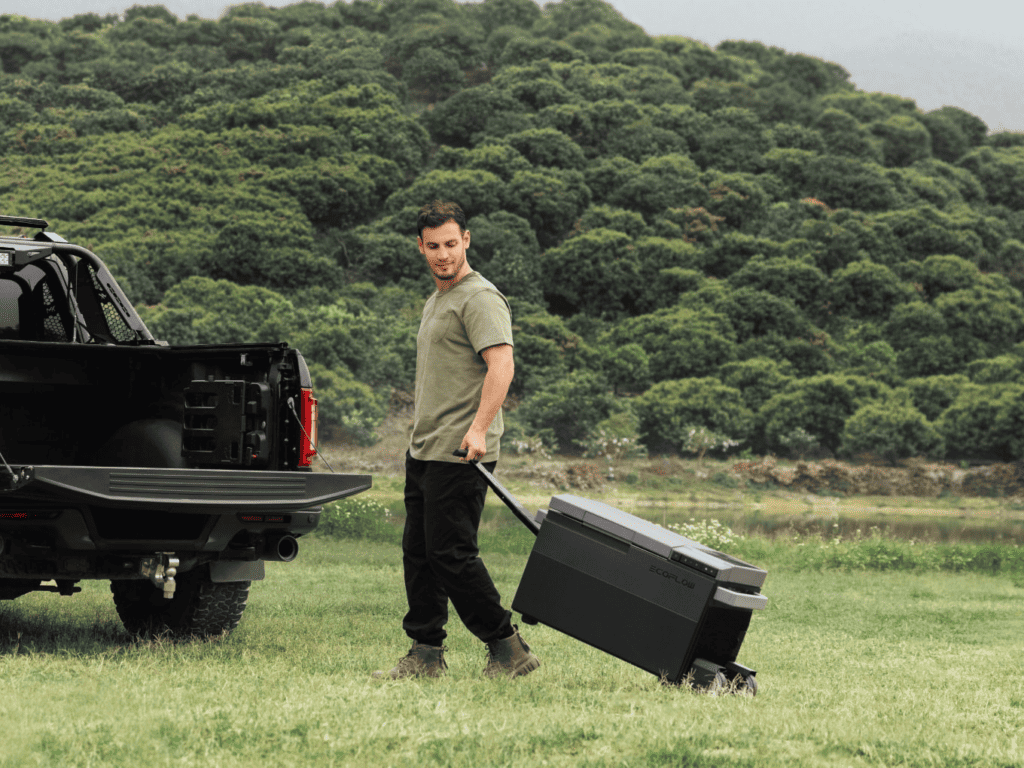
Types of Camping Fridges
There are a million models, but only three basic types of camping fridges.
Here’s a brief summary of each to help narrow down your search.
Compressor Fridges
Almost without exception, every household and commercial refrigerator uses a compressor.
Over 90% of the world’s refrigerators use fixed-speed compressors, though smarter, more efficient compressors have emerged in recent years.
Compressor fridges come in limitless variations, but the basic principles remain the same…
A compressor refrigerator relies on a motor, refrigerant gases like freon (also known as coolants), and other mechanical components like evaporators and condensers to reduce the ambient temperature within an enclosed space.
In simple terms, the combination of a coolant and a motor keeps almost all refrigerators and freezers cold.
Compressor fridges are the only “true” portable refrigerators. Typically compressor-based camping fridges offer temperature control and can also operate as freezers.
Chlorofluorocarbons (CFCs) — like freon — have justifiably earned a reputation as being damaging to the environment. The US began phasing out freon-based compressor fridges in 2010 and has banned the import and production of all hydrofluorocarbons (HCFCs) as of 2030.
Unfortunately, freon remains the most common refrigerant currently in use. But next-generation coolants have little, if any, negative impact on climate change.
In many countries, buying a new fridge that uses HCFCs is not an option. Still, it’s always best to confirm you’re making an eco-friendly purchase decision when shopping for a portable refrigerator.
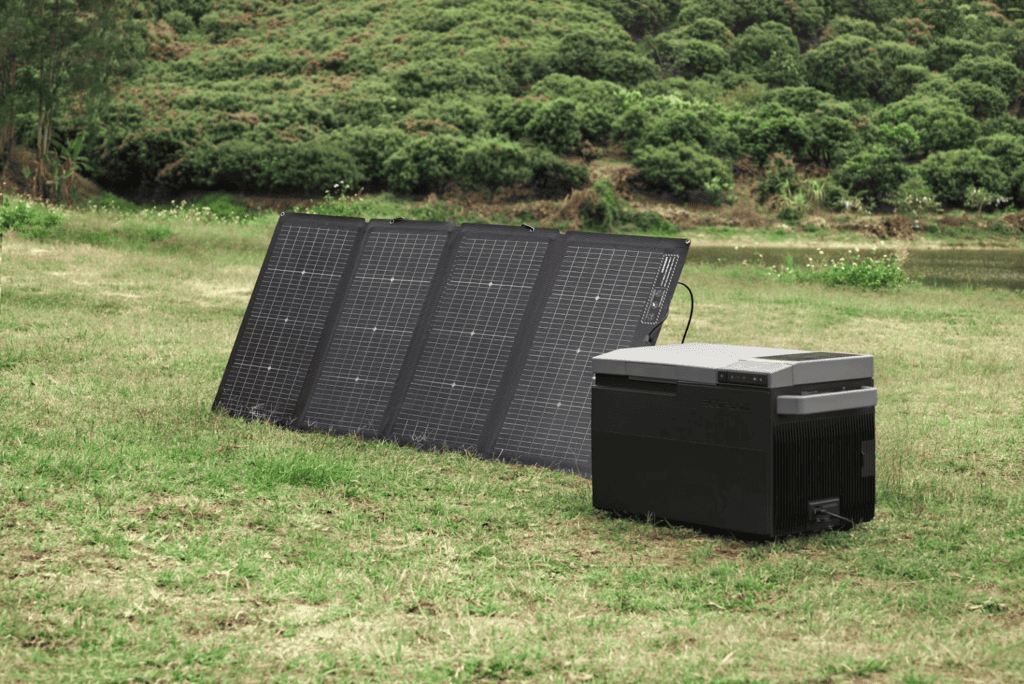
For example, EcoFlow GLACIER has a powerful 120W compressor that can make ice in 12 minutes (!) With the optional plug-in battery, you can operate GLACIER off-grid for 40 hours — or even longer with a 220W Bifacial Portable Solar Panel connected to the built-in solar charging port.
Still not enough?

The Glacier & RIVER 2 portable power station combo gives you three days of cooling power between charges.

Who Are Compressor Fridges Suited For?
Compressor fridges are ideal for those who want a compact but powerful camping refrigerator and freezer.

Compressor camping fridges are also the only option for maintaining food-safe temperatures for longer than a few hours. If you’re looking to keep fresh meat and vegetables, dairy and egg products, or seafood cold and safe for anything longer than a day trip, there’s no need to read further.
Compressor-driven camping fridges are the only safe option for storing perishable food items off-grid for extended periods (even a few days.)
Looking to keep stuff frozen or make ice? Only compressor camping fridges can do that for you. If the answer is yes, your search stops here.
Absorption Fridges
When it comes to power options, absorption fridges are versatile. Most can run on propane (LPG), DC (12V car or RV battery/alternator), or household (AC) electricity.
However, absorption refrigerators are far less energy-efficient than compressor fridges and have many operating restrictions.
In some ways, absorption fridges are similar to their compressor-driven counterparts. Both rely on refrigerants with a low boiling point to operate. Unlike compressor refrigerators, absorption fridges typically use unexotic coolants like lithium bromide and ammonia.
Absorption fridges actually rely on heat to keep things cool, achieving optimal energy efficiency when burning propane. But depending on fossil fuels for refrigeration creates its own issues.
Burning LPG produces toxic emissions like carbon monoxide, which can make you sick or even kill you without adequate ventilation.
Furthermore, absorption fridges must be installed level on a flat, horizontal surface to operate effectively.
Not always the easiest terrain to find when camping.
But even toxic fumes and installation restrictions aren’t the most significant issues for most campers…
The dealbreaker for many is temperature.
If you’re looking to keep things cold in a hot environment — arguably the definition of a refrigerator — absorption fridges will struggle mightily in hot climates.
Absorption fridges are FAR more susceptible to the negative impacts of high ambient temperatures on cooling than compressor fridges.
In other words, the hotter it gets, the worse an absorption fridge works.
If you regularly camp in climates where the temperature exceeds 86°F (30°C), an absorption won’t keep perishable items food safe — let alone frozen.
Who Are Absorption Fridges Suited For?
Absorption fridges are best suited for RV campers who stay in one place for extended periods.
Despite numerous drawbacks, an absorption refrigerator may be viable if you only camp in moderate to cold climates.
Thermoelectric Fridges
Thermoelectric coolers use electricity to cool their contents. By eliminating the need for compressors and chemical refrigerants, they typically consume less space.
Also known as solid-state coolers, thermoelectric fridges use metals like copper or zinc and thermal energy — instead of liquid or gas refrigerants — to keep things cold.
Electricity consumption is considerably higher than with compressor or ambient fridges. While you can operate one with a battery backup or a portable power station, thermoelectric coolers are unsuitable for extended off-grid use.
Thermoelectric camping fridges are also even more susceptible to ambient temperature than absorption fridges. That’s partly why they’re better thought of (and known) as coolers — not refrigerators.
If it’s hot outside, your food won’t stay cold. At least not for long.
Who Are Thermoelectric Fridges Suited For?
A thermoelectric cooler can be useful if you camp at sites in cooler climates with 240V shore power or standard electrical hookups. If all you’re looking for is something to keep beverages and non-perishable items below room temperature, a thermoelectric fridge may be a viable, space-saving solution.
How Many Watts Does a Camping Fridge Use?
The running and starting watts of a camping fridge vary greatly depending on the appliance’s cooling type, size, and efficiency.
Some require as little as 45W, while powerful models need 120W of operating power or more. If you opt for a compressor-type camping fridge, pay close attention to the starting watts.
Motor-driven appliances typically require considerably more electricity to start than they do to operate.
EcoFlow’s GLACIER is an example of a camping fridge on the higher end of running wattage.
GLACIER requires 120W of constant power to operate. But its powerful compressor and expandable battery capacity enable you to refrigerate and freeze perishable items at food-safe temperatures for extended periods off-grid.
It even produces ice in 12 minutes, a feat other camping fridges simply can’t compete with.
Not only is GLACIER’s cooling capacity consistent — it’s FAST. Under optimal charging conditions, GLACIER goes from 86°F (30°C) to 32°F (0°C) in around 15 minutes

What Are the Benefits of Using a Portable Refrigerator Over a Traditional Cooler?
Coolers are cheap and require no maintenance, fuel, battery storage, or electricity.
They’re light and easy to clean.
Ever been on a picnic with beers, water, or wine in a cooler packed with ice?
Then you’re well aware of the benefits.
But a cooler is not a fridge.
If all you’re looking for is a plastic box to keep your drinks cold for a few hours at a tailgate party, you wouldn’t be reading this article in the first place.
Compressor-based camping fridges offer extended storage of perishable items at food-safe temperatures for extended periods.
Even off-grid in the sweltering heat.
If that’s not what you’re after, a traditional cooler — or absorption/thermoelectric fridge — might suit your needs perfectly.
Assess your off-grid or portable refrigeration needs and purchase the appliance that best suits your use case.

What To Look for in a Camping Fridge
Here are the factors to consider
- Fridge Type: Compressor, absorption, thermoelectric fridge, or traditional cooler? There’s no right answer. The best camping fridge for you depends on your requirements. Accurately assess your needs and choose accordingly.
- Interior Volume, Exterior Dimensions, and Weight: You need to balance the amount of food and beverages you want to keep cool against your available space for a camping fridge. Don’t forget to consider the weight (of the appliance and its contents) if portability is a concern for you.
- Temperature: How cold does the camping fridge or cooler get? How fast? How long can it maintain that temperature? What’s the impact of ambient temperature (climate)? What are the recommended food safety requirements for the items you want to refrigerate? Do you need a freezer or ice maker?
Consider all of these questions before making a purchase decision. - Power Source and Consumption: What power sources will you have available when camping? Your camping fridge requirements may be totally different if you plan to only visit campgrounds with electrical hookups rather than venturing off-grid.
- Lifespan and Durability: Crucial considerations when shopping for a battery-powered, off-grid camping fridge.
- Other Features: Want more than just basic cooling? Camping fridges like the GLACIER offer smartphone app control, USB-C charging for personal devices, expandable battery capacity, and solar charging.
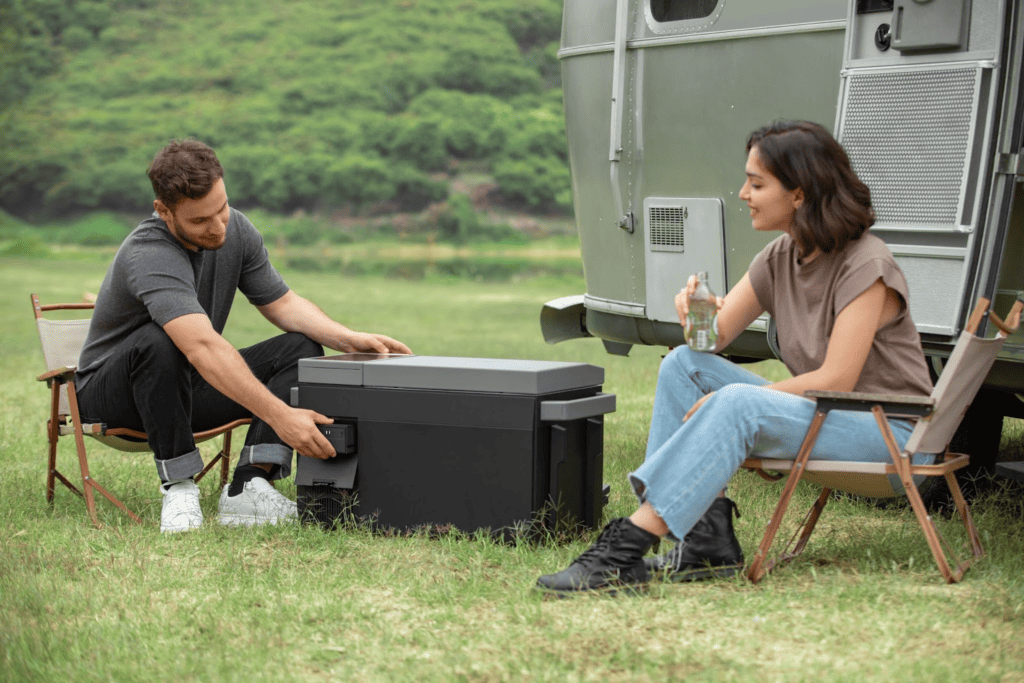
Frequently Asked Questions
Are Camping Fridges Efficient?
Compressor fridges like the EcoFlow GLACIER are energy efficient, fast-cooling cooling, and offer expandable electricity storage — running for up to 40 hours without recharging on the optional plug-in battery alone. Absorption and thermoelectric camping fridges have multiple shortcomings — not least being energy-inefficient.
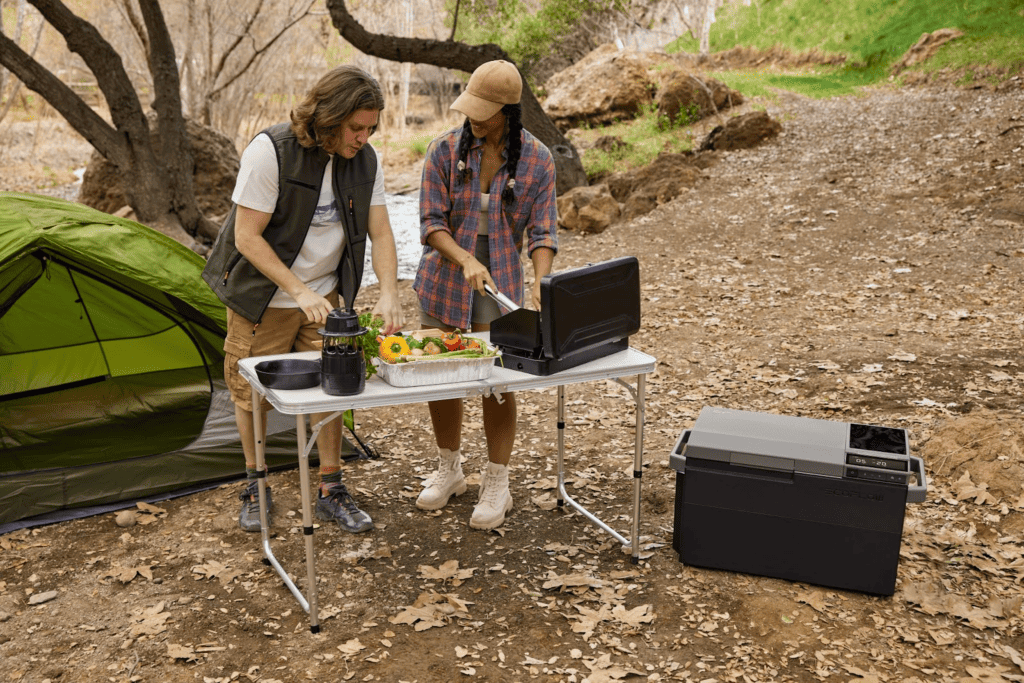
Final Thoughts
The first step towards choosing the best camping fridge is forming an accurate assessment of your needs.
What do you want to keep cold, where, for how long?
Understanding that — and considering the other factors covered in this article — is crucial to making a wise purchase decision. If you’re looking for the most versatile, powerful, and efficient camping fridge for extended periods off-grid, EcoFlow’s GLACIER Portable Refrigerator might be the best choice for you.
